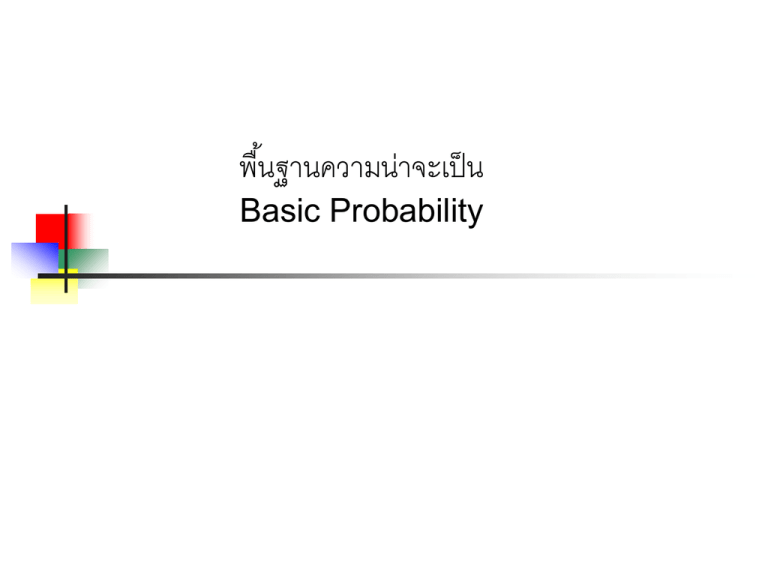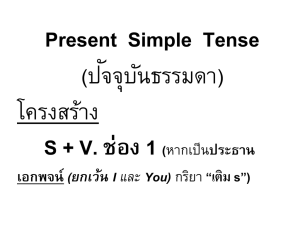11. Basic probability_Revised
advertisement

พื ้นฐานความน่าจะเป็ น Basic Probability Goals วัตถุประสงค์ การเรี ยนรู้ : นิยามความน่าจะเป็ นและอธิบายหลักการเบื ้องต้ นได้ ใช้ contingency tables ในการวิเคราะห์ได้ เข้ าใจและสามารถประยุกต์ใช้ กฏเบื ้องต้ นของความน่าจะเป็ นได้ คานวณความน่าจะเป็ นแบบมีเงื่อนไขได้ เข้ าใจเหตุการณ์ ที่เป็ นอิสระและไม่เป็ นอิสระต่อกัน เข้ าใจและประยุกต์ใช้ กฏของเบย์ (Bayes’ Theorem) สาหรับความ น่าจะเป็ นแบบมีเงื่อนไข Sample Spaces and Events การทดลองแบบสุ่ม (Random Experiments) Sample Spaces and Events การทดลองแบบสุ่ม (Random Experiments) Definition ระบบหรื อการทดลองใด ๆ ที่ผลลัพธ์จากการดาเนินการแต่ละครัง้ มีความ แตกต่างกัน ทัง้ ๆ ที่ดาเนินการหรื อทาการทดลองซ ้าลักษณะเดิม Sample Spaces and Events Sample Spaces Definition Sample Space ตัวอย่าง การโยนลูกเต๋า 1 ลูก 1 ครัง้ จะมีผลลัพธ์ที่เป็ นไปได้ ทงหมด ั้ 6 แบบ การเลือกไพ่ 1 ใบ จากไพ่ 1 สารับ มีผลลัพธ์ ท่เี ป็ นไปได้ 52 แบบไ Sample Spaces and Events ตัวอย่างการนิยาม Sample Space กระบวนการฉีดขึน้ รูปพลาสติก ต้ องมีการควบคุมความหนาของชิ้นงานทีฉ่ ีดขึน้ รู ป พบว่ าความของงานแต่ ละชิ้นไม่ เท่ ากันขึน้ อยู่กบั ปัจจัยต่ าง ๆ เช่ นวิธีการทางาน เครื่องจักร โมล และความละเอียดของเครื่องมือวัด ขนาดความหนาของชิ้นงานทีเ่ ป็ นไปได้ ท้งั หมด สามารถนิยามได้ ดงั นี้ Example (continued) Example (continued) Example (continued) Sample Spaces Tree Diagrams Sample spaces สามารถแสดงได้ ด้วย tree diagrams. เมื่อsample space สามารถวิเคราะห์แยกเป็ นขัน้ ๆ ได้ ถ้ าแทนจานวนทางเลือกของ ผลลัพธ์ที่เป็ นไปได้ ในขันที ้ ่ 1 ด้ วย n1 จะแทนแต่ละทางเลือกได้ ด้วย กิ่งของต้ นไม้ n1 กิ่ง ถ้ าแทนจานวนทางเลือกของผลลัพธ์ที่เป็ นไปได้ ในขันที ้ ่ 2 ด้ วย n2 จะแทนแต่ละทางเลือกได้ ด้วย กิ่งของต้ นไม้ n2 กิ่ง ……………………. Sample Spaces Example 2 การส่ งข้ อความผ่ านระบบ 3 ข้ อความต่ อเนื่อง คุณลักษณะที่สนใจคือแต่ ละข้ อความมาถึง Late และ On time จะได้ Events Simple event Complement ของเหตุการณ์ A (แทนด้ วย A’) เหตุการณ์จาก Sample Space ที่มีเพียงคุณลักษณะเดียว เช่น ไพ่ red card จากไพ่ 1 สารับ ผลลัพธ์ทงหมดที ั้ ่ไม่อยู่ในเหตุการณ์ A เช่น ไพ่ทงหมดที ั้ ่ไม่ใช่หน้ า diamonds เหตุการณ์ร่วม (Joint event) เหตุการณ์ใด ๆ ที่ต้องอธิบายด้ วยคุณลักษณะ 2 อย่างพร้ อม ๆ กัน เช่น ไพ่ ace ที่เป็ นสี แดง จากไพ่สารับหนึง่ Visualizing Events Contingency Tables Ace Not Ace Black 2 24 26 Red 2 24 26 Total 4 48 52 Tree Diagrams 2 Sample Space Full Deck of 52 Cards Total 24 2 24 Sample Space Mutually Exclusive Events Mutually exclusive events เหตุการณ์ที่จะไม่เกิดร่วมกัน example: A = ไพ่ Queen สีแดง; B = ไพ่ Queen สีดา Events A และ B เป็ นเหตุการณ์ mutually exclusive Collectively Exhaustive Events เหตุการณ์รวม เหตุการณ์ใด ๆ จะต้ องเกิดขึ ้น เชตของเหตุการณ์ทงหมดจะครอบคลุ ั้ ม Sample Space example: จากเหตุการณ์ต่อไปนี ้ A = Ace B = สีดา C = ข้ าวหลามตัด D = โพธิ์แดง Events A, B, C และ D เป็ นเหตุการณ์ที่ collectively exhaustive (แต่ไม่ mutually exclusive) Events B, C และ D เป็ นเหตุการณ์ที่ collectively exhaustive Sample Spaces and Events Basic Set Operations Sample Spaces and Events Venn Diagrams Sample Spaces and Events Definition Probability การประเมินเป็ นตัวเลขเกี่ยวกับโอกาสการเกิดขึ ้นของ เหตุการณ์ที่สนใจใด ๆ 1 Certain มีคา่ ระหว่าง 0 ถึง 1 0 ≤ P(A) ≤ 1 For any event A ผลรวมของเหตุการณ์ mutually exclusive และ collectively exhaustive ทังหมด ้ เท่ากับ 1 .5 P(A) P(B) P(C) 1 เมื่อ A, B, and C และ mutually exclusive และ collectively exhaustive 0 Impossible Assessing Probability Approaches to assessing the probability of un uncertain event: 1. a priori classical probability probabilit y of occurrence X numberof ways the event can occur T total numberof elementaryoutcomes 2. empirical classical probability probability of occurrence number of favorable outcomes observed total number of outcomes observed 2-2 Interpretations of Probability Definition The notations may varies depend on the types of books Interpretations of Probability Example 3 Interpretations of Probability คุณสมบัตขิ องความน่ าจะเป็ น Addition Rules Addition Rule:กฏการบวก Mutually Exclusive Events Addition Rules Three or More Events Addition Rules Venn diagram of four mutually exclusive events Addition Rules Computing Probabilities The probability of a joint event, A and B: number of outcomes satisfyingA and B P( A and B) total number of elementary outcomes Computing a marginal (or simple) probability: P(A) P(A and B1) P(A and B2 ) P(A and Bk ) Where B1, B2, …, Bk are k mutually exclusive and collectively exhaustive events Joint Probability Example P(Red and Ace) number of cards that are red and ace 2 total number of cards 52 Type Color Red Black Total Ace 2 2 4 Non-Ace 24 24 48 Total 26 26 52 Marginal Probability Example P(Ace) P( Ace and Re d) P( Ace and Black ) Type 2 2 4 52 52 52 Color Red Black Total Ace 2 2 4 Non-Ace 24 24 48 Total 26 26 52 Joint Probabilities Using Contingency Table Event B1 Event B2 Total A1 P(A1 and B1) P(A1 and B2) A2 P(A2 and B1) P(A2 and B2) P(A2) Total P(B1) Joint Probabilities P(B2) P(A1) 1 Marginal (Simple) Probabilities General Addition Rule Example P(Red or Ace) = P(Red) +P(Ace) - P(Red and Ace) = 26/52 + 4/52 - 2/52 = 28/52 Type Color Red Black Total Ace 2 2 4 Non-Ace 24 24 48 Total 26 26 52 Don’t count the two red aces twice! Conditional Probability สมมติในการผลิตชิ ้นส่วน มีเหตุการณ์ที่สนใจคือ D เหตุการณ์ที่ชิ ้นส่วนบกพร่อง และ F เหตุการณ์ที่ชิ ้นส่วนมีรอยขูดขีดที่ผิว ถ้ าวิศวกรสนใจเหตุการณ์ที่ชิ ้นส่วนบกพร่องเนื่องจากมีรอยขูดขีดที่ผิว (E) จะแทนความน่าจะเป็ นของ E ด้ วย P(D|F) อ่านว่าความน่าจะเป็ นแบบมีเงื่อนไขของ D given F และแปรความหมายว่ าความน่ าจะเป็ นทีช่ ิ้นส่ วนจะบกพร่ องเมื อ่ มี รอยขูดขี ดที ผ่ ิ ว Conditional Probability Conditional probabilities for parts with surface flaws Conditional Probability Definition Computing Conditional Probabilities A conditional probability is the probability of one event, given that another event has occurred: P(A and B) P(A | B) P(B) The conditional probability of A given that B has occurred P(A and B) P(B | A) P(A) The conditional probability of B given that A has occurred Where P(A and B) = joint probability of A and B P(A) = marginal probability of A P(B) = marginal probability of B Conditional Probability Example Of the cars on a used car lot, 70% have air conditioning (AC) and 40% have a CD player (CD). 20% of the cars have both. What is the probability that a car has a CD player, given that it has AC ? i.e., we want to find P(CD | AC) Conditional Probability Example (continued) Of the cars on a used car lot, 70% have air conditioning (AC) and 40% have a CD player (CD). 20% of the cars have both. CD No CD Total AC .2 .5 .7 No AC .2 .1 .3 Total .4 .6 1.0 P(CD and AC) .2 P(CD | AC) .2857 P(AC) .7 Conditional Probability Example (continued) Given AC, we only consider the top row (70% of the cars). Of these, 20% have a CD player. 20% of 70% is about 28.57%. CD No CD Total AC .2 .5 .7 No AC .2 .1 .3 Total .4 .6 1.0 P(CD and AC) .2 P(CD | AC) .2857 P(AC) .7 Using Decision Trees Given AC or no AC: .2 .7 .5 .7 All Cars .2 .3 .1 .3 P(AC and CD) = .2 P(AC and CD’) = .5 P(AC’ and CD) = .2 P(AC’ and CD’) = .1 Using Decision Trees Given CD or no CD: .2 .4 .2 .4 All Cars .5 .6 .1 .6 (continued) P(CD and AC) = .2 P(CD and AC’) = .2 P(CD’ and AC) = .5 P(CD’ and AC’) = .1 Statistical Independence Two events are independent if and only if: P(A | B) P(A) Events A and B are independent when the probability of one event is not affected by the other event Multiplication Rules Multiplication rule for two events A and B: P(A and B) P(A | B) P(B) Note: If A and B are independent, then and the multiplication rule simplifies to P(A | B) P(A) P(A and B) P(A)P(B) Total Probability Rules Partitioning an event into two mutually exclusive subsets. Partitioning an event into several mutually exclusive subsets. Total (marginal) Probability Rules Total Probability Rules Example 4 Total Probability Rules multiple events Independence Definition Independence Definition Example 5 Bayes’ Theorem P(A | Bi )P(Bi ) P(B i | A) P(A | B1 )P(B1 ) P(A | B2 )P(B2 ) P(A | Bk )P(Bk ) where: Bi = ith event of k mutually exclusive and collectively exhaustive events A = new event that might impact P(Bi) การจัดลาดับ (Permutations) การจัดลาดับหมายถึง การจัดเรี ยงรายการสมาชิกโดยสนใจลาดับก่อนหลังใน แซมเปิ ลสเปซของการทดลองสุม่ ใด ๆ มีจานวนวิธีการจัดเรี ยงได้ nPr (อ่านว่า n-P-r) nP r = n! n - r ! เมื่อ r ≤ n การจัดเรี ยง ของ n สิ่ง ซึง่ มีของไม่แตกต่างกัน n1, n2,…, nk สิง่ มีจานวน วิธีการจัดเรี ยงได้ ซึง่ คานวณได้ ดงั นี ้ n Pn1 , n 2 ,...,n k n! n1!n 2!...nk ! เมือ ่ ni < n และ n1 + n2 + … + nk = n การจัดหมวดหมู่ (Combinations) การจัดหมวดหมู่ หมายถึง การจัดกลุม่ ของสมาชิกในแซมเปิ ลสเปซของการ ทดลองสุม่ ใด ๆ โดยไม่สนใจถึงลาดับของสมาชิก ดังนันการจั ้ ดหมวดหมู่จะมี ความแตกต่างเฉพาะสมาชิ กในแต่ละหมวดหมูเ่ ท่านัน้ มีจานวนวิธีการจัด C = หมวดหมู่ nCr (อ่านว่า n-C-r) ซึง่ คานวณได้ ดงั นี ้ n nC r = r n! r!n - r ! เมื่อ r ≤ n








